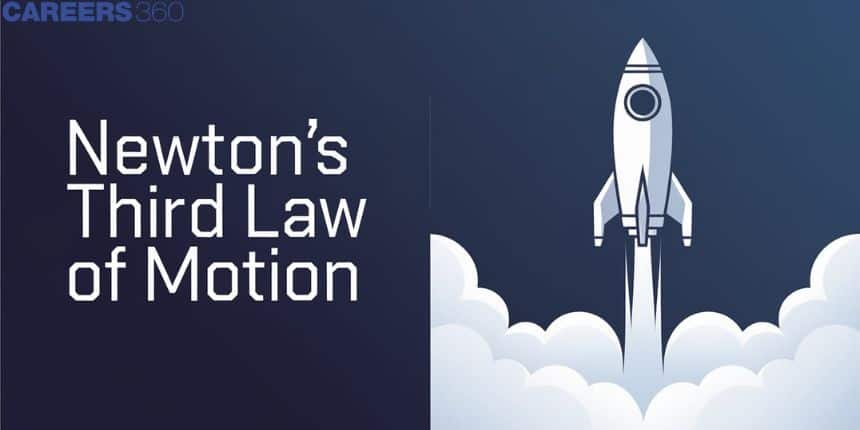Newtons Third Law of Motion - Definition, Examples, FAQs
What is newton’s third law of motion?
Newton’s third law of motion definition: This law states that every action has a matching and opposing reaction. If body A applies force Fa to body B, then B applies force Fb to body A at the same time. Furthermore, the forces exerted on each body are equal in size and opposite in direction: Fa = - Fb.
JEE Main/NEET 2027: Physics Important Formulas for Class 10
NEET 2025: Mock Test Series | Syllabus | High Scoring Topics | PYQs
JEE Main: Study Materials | High Scoring Topics | Preparation Guide
JEE Main: Syllabus | Sample Papers | Mock Tests | PYQs

Furthermore, in some cases, one body between these two determines the direction and magnitude fully. Consider the case where item A is exerting force on object B. The force acting on object B is called "action," while the force acting on object A is called "reaction." As previously stated, this law is also known as the action-reaction pair law, with Fa and Fb standing for action and reaction, respectively.
In some circumstances, however, both bodies work together to determine magnitude and direction. It is irrelevant to say which force is "activity" and which “reaction” in this circumstance is. Furthermore, action and reaction happen at the same time belong to the same interaction, and neither happens without the other.

Two skaters push against each other to demonstrate Newton’s third law of motion. The first skater to the left exerts a normal force of N12 on the second skater to the right, while the second skater to the left exerts a normal force of N21 on the first skater.
Both forces have identical magnitudes but opposite directions, as specified by Newton’s third law of motion class 9.
Also read -
- NCERT Solutions for Class 11 Physics
- NCERT Solutions for Class 12 Physics
- NCERT Solutions for All Subjects
Newton’s third law examples
The action-reaction pair law can also be observed in daily life. Consider the following applications of Newton’s third law of motion class 9:
- An individual On the Road Walking, When a person goes on a walk, the person pushes against the ground in a reverse motion. The ground, on the other hand, applies a forward-directed force to the man or woman, causing them to go forward.
- Swimming: When a person swims, he or she pushes the pool water backward, which is an illustration of Newton’s third law of motion. The water, in turn, propels the swimmer ahead.
- Bird in the Air: A bird, in accordance with Newton’s third law of motion, uses its wings to push air downward. The air, on the other hand, aids the bird's upward movement.
- Rockets, for example, propel themselves forward by ejecting high-velocity gas backward. This means that the rocket applies a significant backward force to the gas inside the rocket combustion chamber, and the gas, in turn, applies a large forward reaction force to the rocket. Thrust is the name for this reactive force. Rockets are commonly misunderstood to propel themselves by pushing on the ground or air behind them. They perform better in a vacuum because the exhaust gases can be expelled more easily.
- Helicopters create lift in a similar way by pushing air down and feeling an upward response force. Birds and airplanes fly by exerting force on air in the opposite direction of the force they require. To get the lift and forward motion, a bird's wings, for example, force air downward and backward.
|
Related Topics, |
Newton’s third law of motion says that when someone walks, they push on the floor, and the floor pushes back. This is Newton’s third law of motion in action. Newton’s third law of motion can be observed in action as someone walks: they push on the floor, and the floor pushes back.
Similarly, a car's tires press against the road, which pushes back on the tires—the tires and road push against each other at the same time. These forces are affected by friction; for example, a person or car on ice may be unable to exert the necessary action force to produce the required response force.
The law of conservation of momentum has been derived from Newton’s third law of motion, conservation of momentum is a more fundamental idea (derived from Galilean invariance via Noether's theorem). In circumstances where Newton’s third law of motion appears to break, such as when force fields and particles both have momentum and in quantum mechanics, this holds true.
Also, check-
- NCERT Exemplar Class 11th Physics Solutions
- NCERT Exemplar Class 12th Physics Solutions
- NCERT Exemplar Solutions for All Subjects
NCERT Physics Notes:
Frequently Asked Questions (FAQs)
If object A exerts a force on object B, object B must reply with a force of equal size and in the opposite direction, according to Newton’s third law of motion.
This law illustrates nature's symmetry: forces always exist in pairs, and one body cannot exert a force on another without also being subjected to one. This law is sometimes referred to as action-reaction, with the action being the force exerted and the reaction being the force received as a result.
Examples of Newton’s third law of motion are:-
An elastic band is being pulled.
Swimming or rowing a boat are two options.
When pushing an object, there is static friction.
Walking.
Standing on the ground or sitting in a chair are both acceptable options.
The rocket's upward thrust.
Resting against a tree or a wall.
Slingshot.
In collisions between two objects, Newton’s third law of motion is naturally applied. When two things collide, forces of equal size and opposite direction are experienced by both objects. As a result of such forces, one object often accelerates (gains momentum) while the other slows down (lose momentum).
When two bodies contact, Newton’s third law of motion states that they apply forces to each other that are equal in magnitude and opposing in direction. The law of action and reaction is another name for the third law.
Also Read
05 Feb'25 04:38 PM
11 Jan'25 03:12 PM
03 Dec'24 04:00 AM
03 Dec'24 03:48 AM
29 Nov'24 11:10 AM
28 Nov'24 01:12 AM
27 Nov'24 11:57 PM
27 Nov'24 02:41 PM
27 Nov'24 02:15 PM
26 Nov'24 03:04 PM